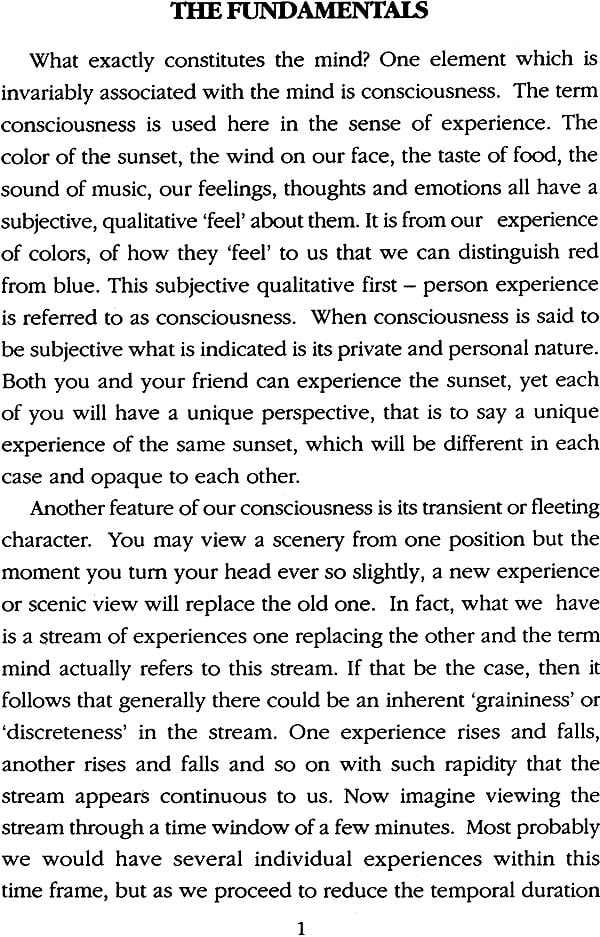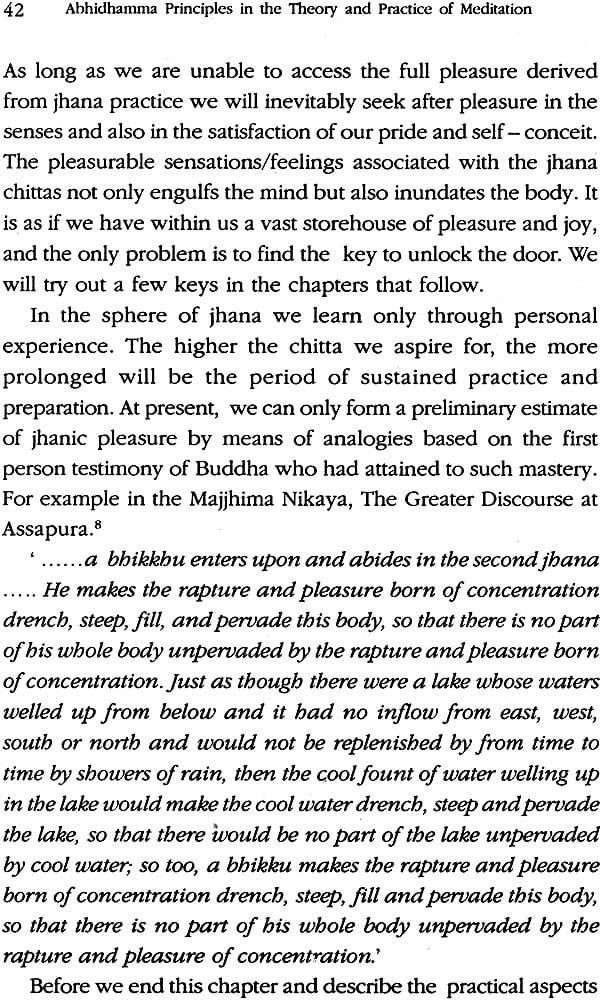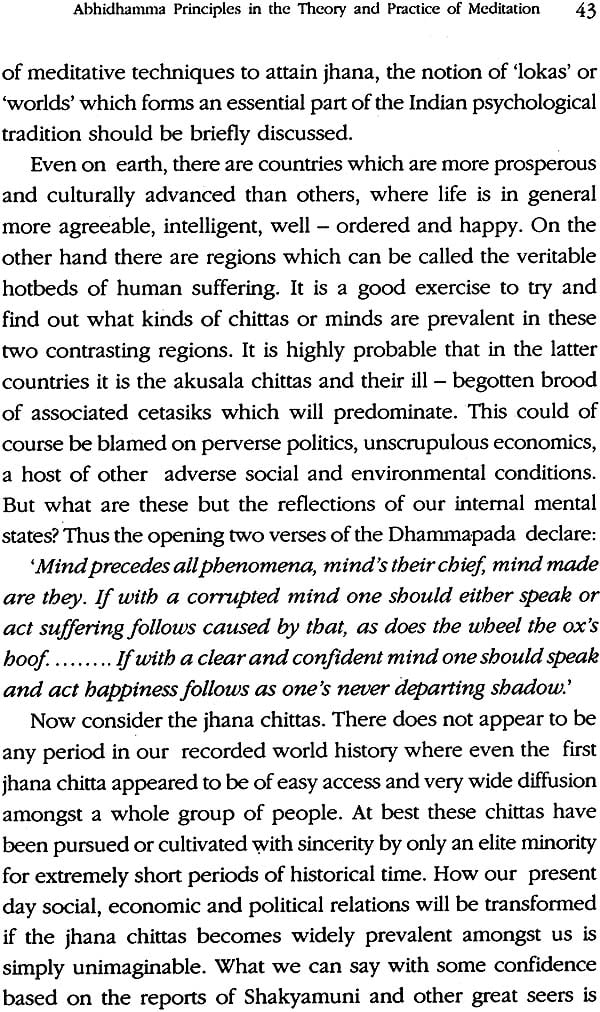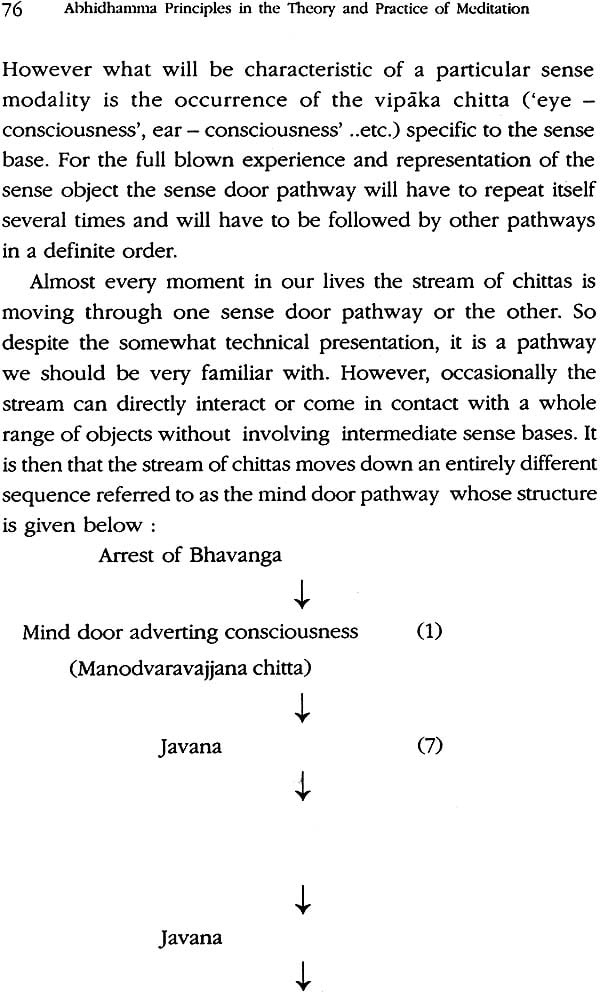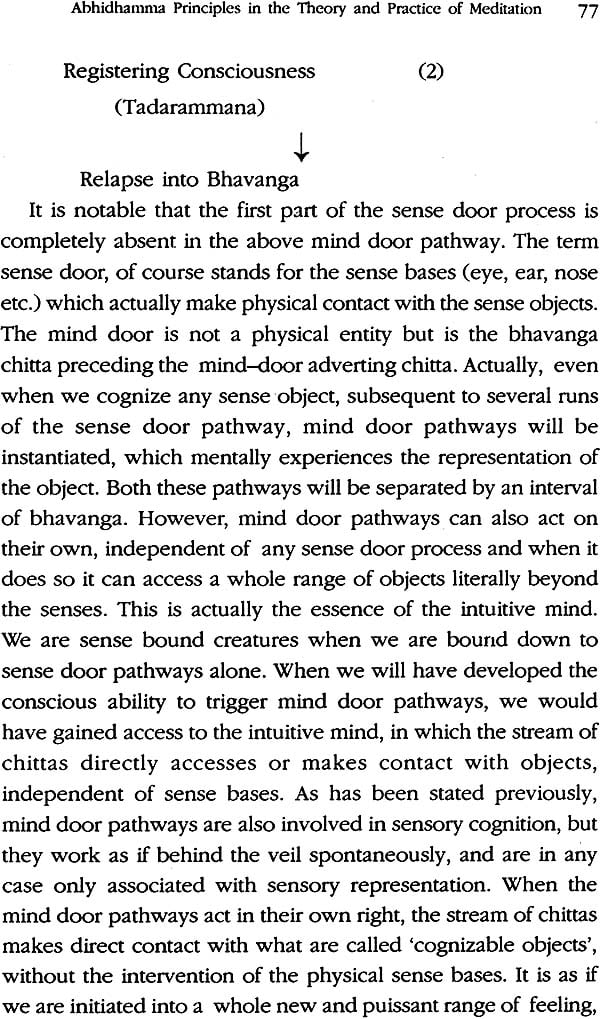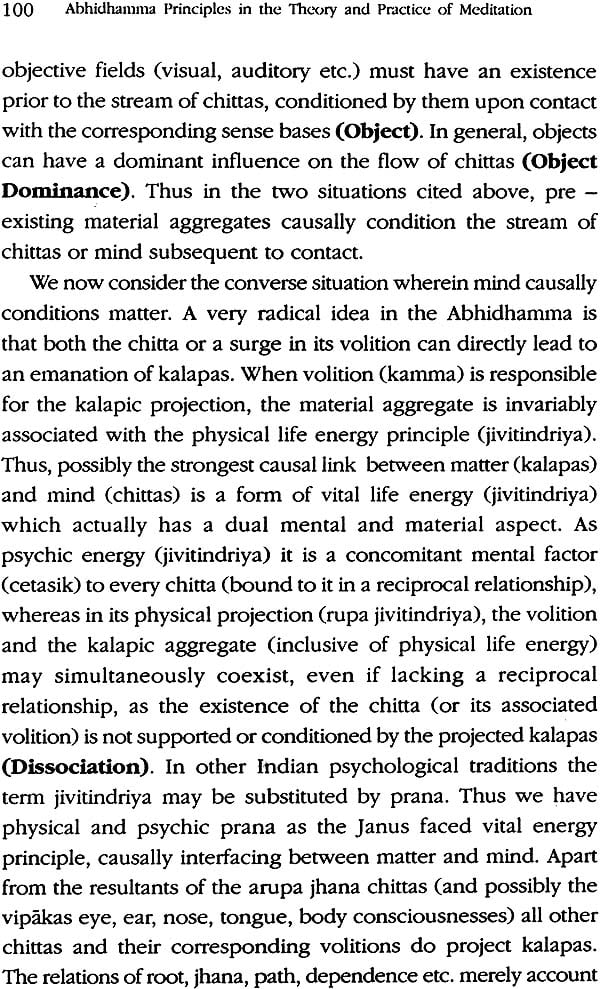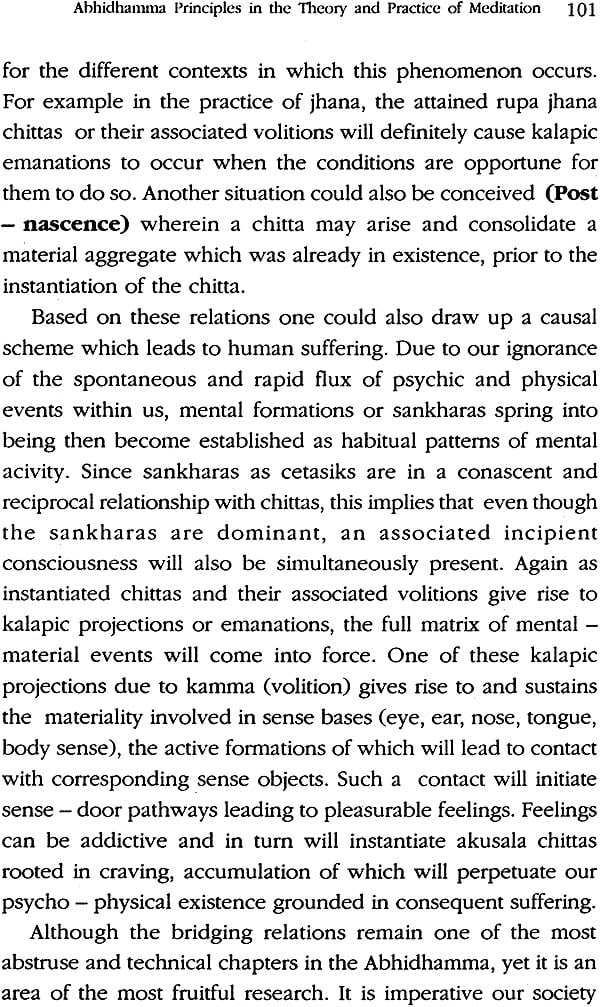
Abhidhamma Principles in the Theory and Practice of Meditation
Book Specification
| Item Code: | NAN008 |
| Author: | Prof. Rahul Banerjee |
| Publisher: | Maha Bodhi Book Agency |
| Language: | English |
| Edition: | 2012 |
| ISBN: | 9789380336596 |
| Pages: | 128 |
| Cover: | Hardcover |
| Other Details | 8.5 inch x 5.5 inch |
| Weight | 280 gm |
Book Description
The Abhidhamma is a set treatises attributed to Shakyamuni Buddha, found in the Pali Canon Tripitaka. Although known to be abstruse, the Abhidhamma remains one of the most profound scriptures related to the understanding of consciousness in Indian analytical thought. In this book some of its essential principles have been highlighted in simple and lucid terms so as to make it accessible to students, academic and those interested in meditation. An added feature of the book is the stepwise instruction for the development of a wide variety of meditative practices (first-person methods) catalogued in the Pali Canon. Thus the book could serve both as a practical guide for those practicing meditative techniques. The simple and trenchant mode of presenting the subject should be attractive to people from all walks of life.
Prof. Rahul Banerjee is a faculty at the Saha Institute of Nuclear Physics, Kolkata, primarily involved in scientific research in the area of biophysics. Studies in consciousness in the Indian traditions, especially the Abhidhamma is also one of his research interests. The major focus of these studies is in the theory and practice of meditation.
The last few decades has seen the reemergence of consciousness as a suitable topic for scientific investigation. There has been a sharply increasing volume of work in the scientific literature related to the various aspects of consciousness both from a philosophical and empirical point of view. Despite such extensive effort the status of consciousness in the natural order and especially how it relates to biophysical events in the brain continues to be an enigma. In the course of these studies, a need to find an adequate theoretical framework to discuss consciousness as a natural phenomenon has been urgently felt. Secondly, since consciousness is essentially as subjective phenomenon sophisticated first-person methods to explore the domain of our conscious experiences will also probably be required. The Abhidhamma, a set of treatises attributed to Shakyamuni has something definite to say regarding both the theory and meditative practices used to probe the conscious mind. This slender volume addressed to both students of science and those interested in meditation, provides an introduction to the Abhidhamma model of mind and also the first person methods which were used to validate the model. It is hoped this book will encourage readers to take up meditation and study the original sources or provide fruitful ideas for scientific research. The author is especially grateful to Prof. Bikas K. Chakrabarti, Head, Centre for Applied Mathematics and Computational Science, under whose aegis research into meditation from both empirical and theoretical approaches have been performed at the Saha institute, Kolkata, for the last five years.
We all want to be happy. A few thousand years ago a prince decided to dedicate his life to resolve this issue, concerning human happiness. Sidhartha Gotama, later called the Buddha, asked a truly fundamental question:-
Why and how do men and women make themselves miserable? Or conversely, what should one do in order to be truly happy?
This book deals with some of the answers which he got following a long, hard and arduous search. Before we begin to delve into the picture which began to emerge from his assumptions which Buddha made, probably at the start of his stupendous effort.
Most often when men and women suffer anguish, they blame it on fate, destiny, probable God and definitely on others. What this really means is that they admit that most of the causal factors which are responsible for their condition are actually beyond their control. Extreme conditions which cause widespread suffering could be war, famine, pestilence, natural disasters or financial and social turmoil. Even without these violent circumstances our lives provides us with many an occasion where we are apprehensive of unhappiness. It could be the loss of a loved one, failure or frustration with regard to some deeply held personal desire. Although the external circumstances which causes human suffering could be infinitely varied, it is probably true that some ‘internal conditions’ have also to be satisfied either individually or collectively, predisposing men to grief and despair. Here the word ‘internal’ refers to subjective states involving mental attitudes, inclinations, intentions, emotions and beliefs. This was precisely Buddha’s domain of enquiry. Thus, the question raised by him could be rephrased, as to what are the internal conditions involving mental attitudes, intentions, beliefs and emotions which invariably get external circumstances? or conversely what are the internal conditions which have to be satisfied in order to make men happy?
In pursuit of an answer, Buddha experimented with many different meditative methods and ascetic practices. Although he was open to a variety of suggestions and leads, which could give him some clue to the resolution of this enigma, he was careful to personally test every method to see whether they delivered the anticipated results. His attitude can best be summed up by the celebrated discourse he gave to Kalama’s, a trible group settled in northern India, who were quite bewildered and confused by the plethora of philosophical views in circulation at that time.
‘Come Kalamas, ‘he told them, ‘do not simply believe whatever you are told, or whatever has been banded down in tradition, or what is common opinion, or whatever the scriptures say. Do not accept something as true merely by deduction or inference, or by partiality for a certain view, or because of its plausibility, or because your teacher tells you it is so. But when you yourselves directly know, “These principles are unwholesome, blameworthy, condemned by the wise; when adopted and carried out they lead to harm and suffering”, then you should abandon them. And when you yourselves directly know, “These principles are wholesome, blameless, praised by the wise; when adopted and carried out they lead to welfare and happiness for me and other,” then you should accept and practice them.
Knowing ‘directly’ means knowing first- hand in one’s own personal experience and if something is really true than it should also be cross- validated in the similar experiences of others (‘the wise’).
When results began to come in as consequences of Buddha’s relentless efforts and his solution to the conundrum began to take a definite shape, he refused to harbor a dogmatic approach to the subject. Even though he was very decisive and consistent will regard to certain aspects of the problem, he invariably conceded that others had a right to their own views. When differences were apt to become very intense, he would simply smile and remark that it must be difficult for his protagonist to understand him as he was accustomed to a different persuasion. On being accosted by an especially aggressive Brahmin who considered ‘only the Vedic hymns to be true and everything else to be wrong’, Buddha further clarified.
‘There are five things Bharadvaja that may turn out in two different ways here and now. What five? Faith, approval, oral tradition, reasoned cogitation, and reflective acceptance of a view. These five things may turn out in two different ways here and now. Now semthing may be fully accepted out of faith, yet it may be empty, bollow and false; but something else may not be fully accepted out of faith, yet it may be factual, true, and unmistaken. Under these conditions it is not proper for a wise man who preserves truth to come to the definite conclusion:” Only this is true, anything else is wrong.”
Then the Brahmin further asks,
‘But, Master Gotama, in what way is there the preservation of truth? How does one preserve truth?...
And Buddha replies,
‘If a person has faith, Bharadvaja, he preserves truth when he say: ‘My faith is thus’; but he does not yet come to the definite conclusion:’ Only this is true, anything else is wrong.’ In this way, Bharadvaja there is preservation of truth…..’
As has been mentioned before it was clear to Shakymuni that this complex of mind and body which we call ourselves is sustained by a matrix of causal events. Enumeration and elucidation of what these events precisely are, was of course the whole object of his effort. However, it follows that both our happiness and misery are a natural consequence of a network of inter- related causal factors which have come into existence. Some of these factors are external, though probably, in human affairs the most compelling of them could be internal or subjective. As knowledge is power, these subjective causes once identified can be brought under our control by well directed meditative practice. The practice of meditation is thus what Buddha primarily taught. Meditation, then is practiced firstly to generate and sustain internal conditions conducive to well- being, pleasure and happiness, and secondly to explore other forms of ‘knowing’ which could be called ‘intuitive’ in contrast to strictly rational modes of knowledge. An entire psychology for the intuitive mind was developed by the Buddha and at this preliminary stage it can only be added that final deliverance from unhappiness will be possible when the intuitive mind is firmly and universally established amongst us, rather analogous to the current widespread use and prevalence of rationality in some form or the other in our daily lives. Some of the most profound conclusions of the Buddha have been preserved in the Abhidhamma, a collection of seven treatises in the Pali Canon Tipitaka.
In the following pages of this book, both the intellectual model of the mind and the meditative practices developed by Shakymuni have been described. This is neither a polemical nor a scholastic work on Buddhist philosophy. Rather it should serve as a practical meditation manual interspersed with relevant theoretical considerations, for those who would like to explore alternative paths to knowledge and personal fulfillments.
| Preface | vii | |
| Introduction | xi | |
| The Fundamentals | 1 | |
| Akusala Chittas- The Domain of Suffering | 7 | |
| Vipaka Chittas- The Resultants | 15 | |
| Sobhana Chittas- The Beautiful Mind | 19 | |
| Meditation With Thought- The Access Level | 27 | |
| The Jhanic States and Many Worlds | 37 | |
| The Practice of Jhana- | 45 | |
| Kasina Meditations- The Arupa Jhana Chittas and Arrest | 61 | |
| Pathways and The Intuitive Mind | 73 | |
| Vipassana- The Surge to Nibbana | 81 | |
| Liberation by the Beautiful | 89 | |
| The Bridging Realations | 93 | |
| Putting it all Together | 103 | |
| Appendix I | 107 | |
| Quotations | 110 | |
| Selected Bibliography | 111 | |
| Index | 113 |
